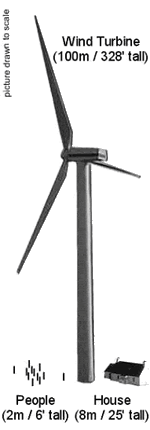Letter to the Ellis County Commissioners
The following letter was mailed by Benjamin Faber to the Ellis County Commissioners on August 31.
Dear Honorable Commissioners,
In these days leading up to the vote on the Ellis County Wind Farm issue, I can imagine you have been swamped with letters and other attempts to sway your vote a certain way. One of these letters was brought to my attention, which was written by a local farmer who supports the development of a wind farm. As we live in a democratic society, I feel that it is my duty, and I know you also feel the same way, to stay informed on the current issues of our society, in this case, the wind farm. I know that by being elected by your fellow countrymen that you recognize the responsibility to listen to both sides of an argument and make your decision rationally. This letter is only an attempt to offer a rebuttal to the afore mentioned letter with the hopes that it will supply you with enough information to make a wise decision for the community.
One consideration you should take into account when evaluating the information provided to you is the source from which it comes. The previous letter cites various pieces of scientific information of varying complexity and topic. Most of this information lies in the field of acoustics, which is the physics of sound. The author of this letter is a farmer who, to the best of my knowledge, does not a degree in the area of physics. I, on the other hand, am in my third year of study as a physics major in college. I have studied the area of acoustics in depth in my classes and on my own. I appreciate the author’s attempts to convey scientific knowledge to you, but he did not do it accurately.
The rest of this rebuttal will be in the form of point/counterpoint.
Point #1: Increasing the setbacks is a violation of property rights.
The last time I checked the operations of government, the zoning regulations were designed to protect those who are not directly involved with making alterations to environment. This would include proper location of such features as landfills, hazardous industry and infrastructure needs (such as interstate highways, railways, etc.). Setting back a wind power generation complex is no different. It does not violate the rights of the property owner; on the contrary, the zoning regulations protect these property owners and all landowners and residents from my asking that a hazardous industry come operate on my land within 1000 feet of their property and residence.
Point #2: Vibro-Acoustic Disease is a myth.
This could not be further from the truth. In the letter to you, the author cites a study by Dr. Mariana Alves-Pereira, a distinguished Portuguese scholar in the area of medicine. Her reports have been published in various medical journals, like the influential journal Noise and Health. The findings reported in the previous letter will presented at the Wind Turbine Noise Conference 2007 in
The author also states that no case of VAD has ever been reported. This is completely umtrue. The author cites personal experiences of himself flying in the Navy and those of his colleagues. VAD comes in a variety of different forms, from mild to severe. The more mild symptoms are a general feeling of motion sickness and headaches. On the severe end, VAD has been seen to cause numerous cardiovascular and breathing problems. One condition required to develop VAD is a constant exposure to low-frequency noise. Logging 4000 hours of flight time is a long time, but it is in discrete events. The wind farm will always be there and always be generating power. In the Navy records of the flight crew that is constantly exposed to the infrasound of the plane engines you would find a preponderance of cardiovascular and respiratory maladies. These are consistent with the symptoms of VAD.
The lack of sleep is another common problem. The author gives another personal experience of being sleepy in college during the middle of the day. As a current college student, he has my sympathy. I too am tired during the middle of the day. However, as the author can surely attest, his lack of sleep at night was not due to an unbearable noise source. I, like most students, do not get much sleep due to other obligations, but when I do sleep, I sleep straight through the night. Those who are situated near wind turbines and cannot sleep give the general feeling of insomnia as their primary cause. This insomnia is brought on by the annoying vibrations of the windmills all through the night. I am sure that you yourself would not want to suffer through sleepless nights, so why should other people?
Point #3 We can threaten you with lawsuits to coerce you into approval.
The author makes an attempt to threaten the country with a lawsuit if he does not get his way. I think I have your agreement when I say that that is not a very noble and democratic solution to a problem. He says the medical evidence would not stand up in a court of law. I can assure you that it will. There is no reason to feel like you need to be pushed around and bullied into approving a measure that you are not sure of yet. He seems to be in the business solely for the purpose of personal gain and will not let hindrances such as the rights of others get in his way.
I hope this information I have provided in this rebuttal has helped you come to well-researched rational decision. From the material I provided I hope I have made it clear that all that is needed are proper setbacks from those
Thank you,
Benjamin J. Faber

